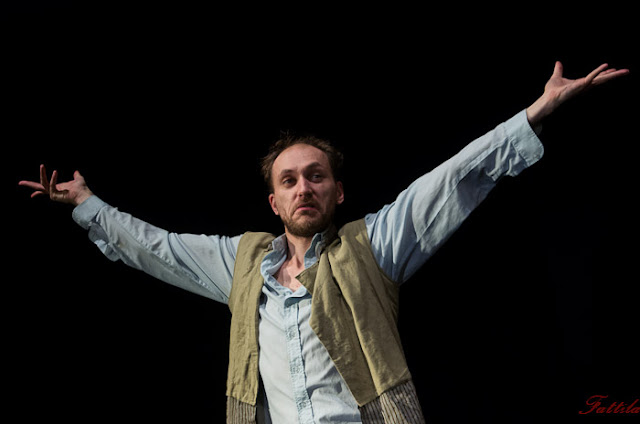Personal details:
Name: Lénárd Ilyés
Date of birth: 31. 10. 1981.
Place of birth: Orosháza
Contact: 0036-20 969-5849
ilyesleo@gmail.com
Qualification:
2000-2006: University of Szeged Faculty of Arts, hungarian literature
2002-2006: Actor School in the National Theatre of Szeged
Langueges:
english (fluent); german (basic)
Important roles:
Formanek -Ilyés - Pignitzky
Book of the dead (International physical theatre performance)
Teatr Novogo Fronta (Prága):
Home scape projekt (International physical theatre performance)
Gobe Dance Company:
Tolnai dancecyclopedia (contemporary dance theatre performance)
Utca - szak:
Heroes of Hungary (musician, conspirator; commedia de’ll arte performance with masks)
Equusproductions:
Equus (Martin Dysart; english version)
Theatre on the roof:
Glass menagerie (Tom; english version)
Own productions:
Novecento (monologue); Algernon-effekt (monologue)
National Theatre of Szeged:
István, the king (Solt); Popfestival of Midsummer Night's Dream (Lysander); Pulp fiction (Pumpkin; Marvin; English Dave; Lance; Elvis Presley; Bob Marley; Zed; Wolf)
Cellar Theater of Szeged:
Elektra, my love (Actor); Karnyóné (TippTopp); Three nights of one love (Viktor);
Theater of Budaörs:
Tales of Hollywood (Harpo); Rag-and-bone children (Friendly man)
Ködszurkálók Company:
Paperflowers (Sneci)
Andaxínház:
No reason to fear; Wawe
Radical Freetime Theatre:
The dumb waiter (Ben, Gus); Oberon's world (Oberon); The Misanthrope (Oronte)
ImproTest
Monthly dance improvisation performance in the Trafo House
Workshops:
Street theater workshop of Münster 2002; Moving improvisation labor with Kocsis László Szúnyog 2004; Commedia de’ll arte workshop with Eleonora Fuser 2008; Japanese Mime-workshop with Hiroyasu Sasaki 2009; Strassberg training with Paolo Antonio 2010; Movement workshop with Csetneki Gábor 2010; Clown workshop with Quinn Bauriedel, 2010; Laban workshop with Kővári Ágnes 2011; Butoh-training with Bata Rita 2011; Oleg Zsukovszkij workshop 2011; Butoh workshop with Akira Kasai 2011; Butoh workshop with Ko Murobushi 2011; Butoh workshop with Yumiko Yoshioka 2011; Workshop with Palle Granhoj in Prague 2012; Theatrical workshop Wroclaw, Grotowski Institute 2013; Sizar on Andrew Hafler improvisation workshop 2013;
-----
Képzettség:
2000-2006: Szegedi Tudományegyetem BTK, magyar tanár
2002-2006: Szegedi Nemzeti Színház Stúdiója (színész 2)
Nyelv:
angol, német
Speciális jártasságok:
torokéneklés; gólyaláb
Fontosabb szerepek:
Szegedi Nemzeti Színház: István a király (Solt); Szentivánéji Popfesztivál (Lysander); Ponyvaregény (Tökfej; Marvin; Angol Dave; Lance; Elvis Presley; Bob Marley; Zed; Wolf)
Szegedi Pinceszínház: Szerelmem, Elektra (Csepűrágó); Karnyóné (TippTopp); Egy szerelem három éjszakája (Viktor); Novecento (monodráma)
Budaörsi Játékszín: Hollywoodi mesék (Harpo); Kukabúvárok (Jóindulatú férfi)
Ködszurkálók Társulat: Papírvirágok (Sneci)
Gobe Dance company: Tolnai tánclexikon
Andaxínház: Nincs mitől félni; Kísérlet/Hullám
Radikális Szabadidő Színház: Az étellift (Ben, Gus); Oberon világai; Mizantróp (Oronte)
Utca-szak: Magyarország hősei (zenész, összeesküvő; maszkos commedia de’ll arte előadás)
Teatr Novogo Fronta (Prága): Home scape projekt (Nemzetközi fizikai színházi előadás)
Saját produkció: Algernon-effektus (monodráma) Charles Gordon
Angol nyelvű előadások:
Equusproductions: Equus (Martin Dysart)
Theatre on the roof: Glass menagerie (Tom)
Workshopok:
Utcaszínházi workshop Münster 2002; Mozgásimprovizációs műhely Kocsis László Szúnyoggal 2004; Commedia de’ll arte tréning Eleonora Fuserrel 2009; Japán Mime-workshop 2009; Strassberg-tréning Paolo Antonio-val 2010; Clown workshop Quinn Bauriedel-el 2010; Mozgásszínházi Workshop Oleg Zsukovszkij-al 2011; Német táncszínházi workshop Efrat Stampers-el és Martin Stiefermann-al 2011; Butoh workshop Akira Kasai-al 2011; Butoh workshop Ko Murobushi-val 2011; Butoh workshop Yumiko Yoshioka-val 2011; Színházi workshop Wroclaw Grotowki Institute 2012; Prága, Palle Granhoj workshop 2012; Ösztöndíjas színész Andrew Hafler improvizációs workshopsorozatán (2013)















